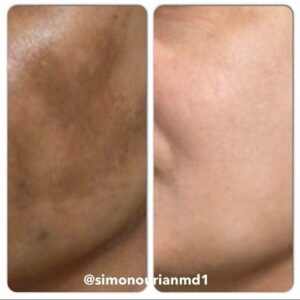This article will explore laser therapy as a remedy for melasma, a common and often challenging skin condition. Let us explore the intricacies of using laser precision to treat melasma, shedding light on the mechanisms and outcomes of this approach, which aims to demystify how laser technology is applied in treating melasma, revealing its ability to target and transform pigmented skin. With effective laser therapy, there is potential to restore clarity and confidence to those dealing with melasma.
How does laser technology effectively treat melasma?
In melasma treatment, laser technology employs beams of light to specifically target and break down excessive pigmentation in the skin.
Selective photothermolysis is a process wherein laser systems emit chosen wavelengths of light that are absorbed by melanin (the pigment) present in melasma patches. This process is known as photothermolysis. Laser treatment focuses on targeting the melanin in pigmented areas, causing the pigment cells to be destroyed or fragmented. Over time, the body’s natural processes eliminate the pigment, allowing the skin to gradually regain an even tone. Laser therapy is effective in treating melasma as it specifically targets areas while leaving the surrounding skin unaffected.
However, its success may vary depending on factors such as the type and severity of melasma, the specific laser used, and individual skin characteristics. Optimal results often require sessions, so it is crucial to consult with a dermatologist to determine the suitable laser approach for managing melasma.
Can laser therapy completely get rid of melasma?
Laser therapy is primarily used for improving and managing melasma rather than completely eliminating it. Melasma can be challenging to eradicate. Laser treatment can help reduce pigmentation appearance and enhance overall skin tone. It is important to remember that management strategies and sun protection play a role in maintaining outcomes.
What are some risks and side effects associated with laser treatment?
The use of laser treatment for melasma may have some side effects like skin redness, swelling, and changes in pigmentation. However, these risks can be minimized by choosing the type of laser and following care after the treatment. It is important to consult a dermatologist to manage these risks and create a treatment plan.
How long does the effect of laser therapy last?
Typically, noticeable improvements can be seen after sessions of laser treatment for melasma. The duration of results may vary. With maintenance and sun protection, they can last for a significant period of time. To maintain the effectiveness of Melasma laser treatment, it is recommended to follow a skincare routine that includes cleansing, moisturizing the skin, and protecting it from the sun using a broad-spectrum sunscreen. Additionally, wearing clothing and minimizing sun exposure are measures for maintaining the effectiveness of this treatment.
In summary, through our exploration of laser technology, we understand its ability to rejuvenate skin that is affected by pigmentation concerns. It is important to keep in mind that achieving clearer and more radiant skin requires the guidance of dermatologists and a commitment to a treatment routine that includes sun protection and proper care. Embrace the potential that laser therapy provides, allowing your inner radiance to shine brightly with Dr. Ourian’s treatments.
